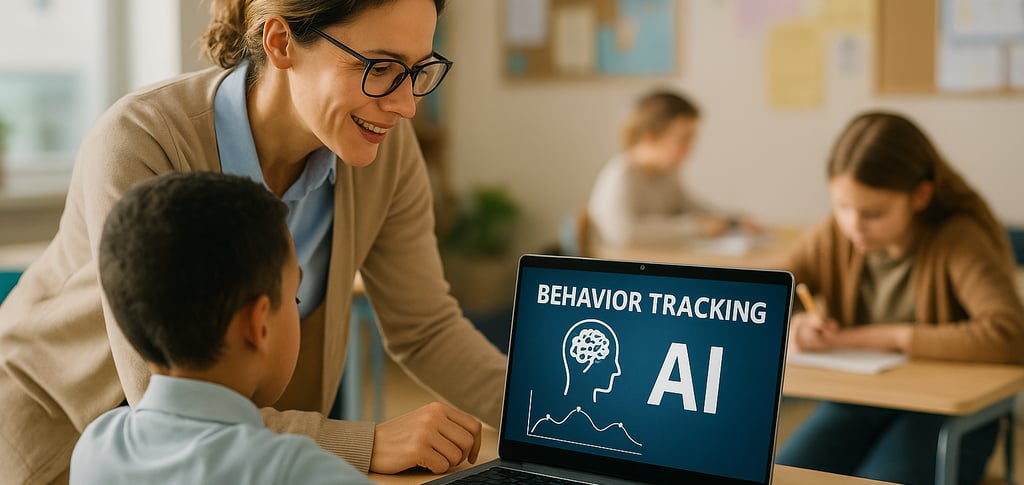AI for Classroom Management: Reduce Behavior Problems Using Smart Tools
Discover how AI tools help teachers reduce behavior problems, improve classroom routines, and support student engagement. Learn how smart technology strengthens classroom management in both rural and urban schools.
11/25/20253 min read


Classroom management has become one of the toughest challenges in teaching today. Whether you’re working in a rural district with limited support or in a busy urban classroom with diverse learning needs, behavior issues can quickly take away precious instructional time and leave teachers feeling exhausted. The good news is that modern AI tools are giving educators new ways to manage behavior, increase engagement, and restore calm even in classrooms that don’t have many devices or strong internet. AI isn’t here to replace teachers; it’s here to support them with data, structure, and smart strategies that make classrooms more predictable and student-centered.
See also: 5 Simple AI Tools Teachers Can Use Daily
Across the country, teachers are facing larger class sizes, more students dealing with anxiety or trauma, rising academic pressure, fewer support staff, and more digital distractions than ever before. These challenges create environments where misbehavior becomes easier and classroom energy becomes harder to control. While AI can’t solve every issue, it can make management far more efficient by helping teachers understand what students need, identify early warning signs, and reinforce positive habits consistently.
One way AI improves behavior is through real-time engagement tracking. Tools like Edusense, ClassroomQ, and Lightspeed Classroom give teachers instant insight into who is on task, who is distracted, and who may need help. Instead of guessing why a student is struggling, teachers can use visual dashboards, heat maps, and device monitoring to understand what’s happening moment by moment. This makes classroom intervention quicker, calmer, and more effective.
AI also makes it easier to create personalized behavior plans. Writing PBIS plans, reward charts, parent letters, or intervention strategies can take a lot of time. AI tools such as MagicSchool AI and Eduaide allow teachers to describe a student’s behavior and instantly receive a customized plan that they can edit and use immediately. This includes structured routines, reflection prompts, SEL strategies, and communication templates teachers can share with parents or administrators. The result is a faster, more personalized behavior-support system that doesn’t overwhelm teachers with paperwork.
Positive reinforcement becomes much more engaging with AI as well. Platforms like ClassCraft and ClassDojo transform classroom expectations into game-style missions, rewards, and character-building experiences. Students earn points for participation, teamwork, and responsibility, which increases motivation and reduces behavior problems without relying on punishment. These tools help teachers build a positive culture that students are excited to be part of.
Emotional regulation is another key area where AI provides support. Many behavior challenges begin when students don’t know how to manage their feelings. AI-powered SEL tools such as MoodMeter, Along, and Microsoft Reflect guide students through check-ins, mood tracking, and self-expression. These tools help students understand how they feel, what triggers them, and what strategies can help them refocus. For teachers, this offers valuable insight into emotional patterns that may influence classroom behavior.
AI can also detect early warning signs that might go unnoticed. Behavior dashboards highlight patterns such as repeated off-task behavior, common trouble times (like after lunch), subjects where frustration rises, or students who are disengaging more frequently. Instead of reacting after a problem escalates, teachers gain insight that allows them to step in proactively and prevent larger issues.
Another major benefit is AI’s ability to create classroom procedures and routines. Teachers can use AI to generate first-week routines, calm-down procedures, group rotation plans, transition strategies, and even call-and-response cues. These routines can be adapted for any grade level, including elementary, middle, high school, special education, or English learners. The more consistent the structure, the easier it becomes to prevent behavior issues.
Even language support during behavior moments becomes easier with AI. Many teachers struggle to find the perfect words in stressful moments. AI can generate calming redirection phrases, de-escalation language, encouraging reminders, and tiered intervention scripts. Having these phrases available helps teachers maintain a calm, neutral tone something that can dramatically reduce power struggles and emotional escalation.
For classrooms with limited technology, AI can still make a big impact. Teachers can use AI to create printable reward charts, SEL check-in cards, visual schedules, reflection sheets, posters, parent letters, and behavior scripts. These resources work offline and still bring structure and clarity to the classroom.
To understand how powerful this can be, imagine needing a behavior plan for a 3rd grader who frequently calls out in class. With a single AI prompt, teachers can instantly receive a complete plan that includes clear goals, reward ideas, consequences, SEL strategies, a parent communication template, and a reflection sheet. What normally takes 30–40 minutes can be prepared in seconds.
While AI offers incredible support, it’s important to use it safely. Teachers should always protect student privacy, avoid using student names in AI tools, and treat AI outputs as drafts, not final decisions. Plans should be reviewed with parents, administrators, and support teams to ensure they align with school expectations.
Ultimately, AI won’t replace a teacher’s empathy or classroom presence, but it can absolutely reduce stress and create calmer, more efficient learning environments. For teachers in both rural and urban settings, AI provides better structure, stronger routines, personalized behavior strategies, SEL guidance, and faster interventions. Even using AI to support one behavior challenge each week can make a noticeable difference in how smoothly the classroom runs.
Contact
Get in touch
Subscribe
info@teacheraidaily.com
© 2025. All rights reserved.